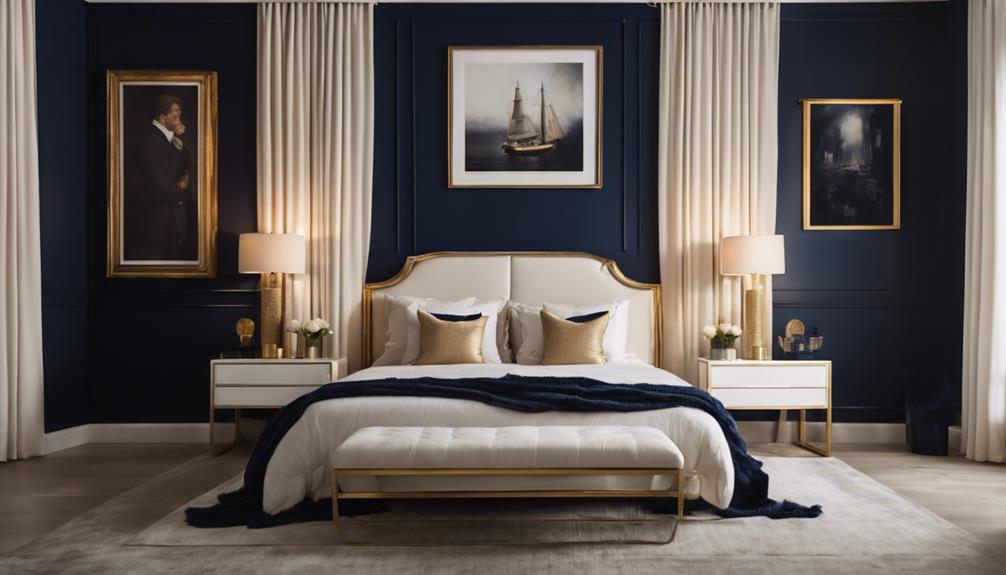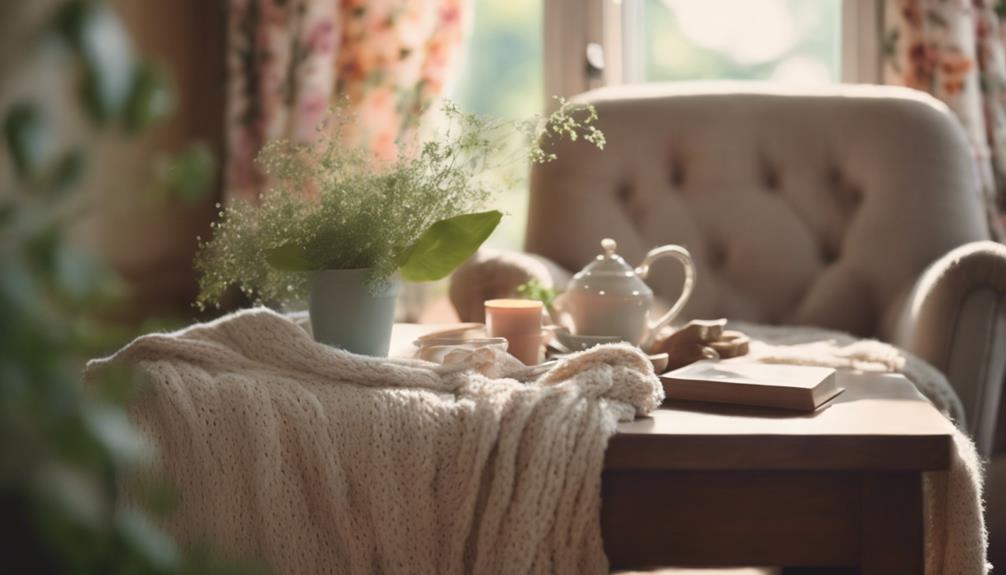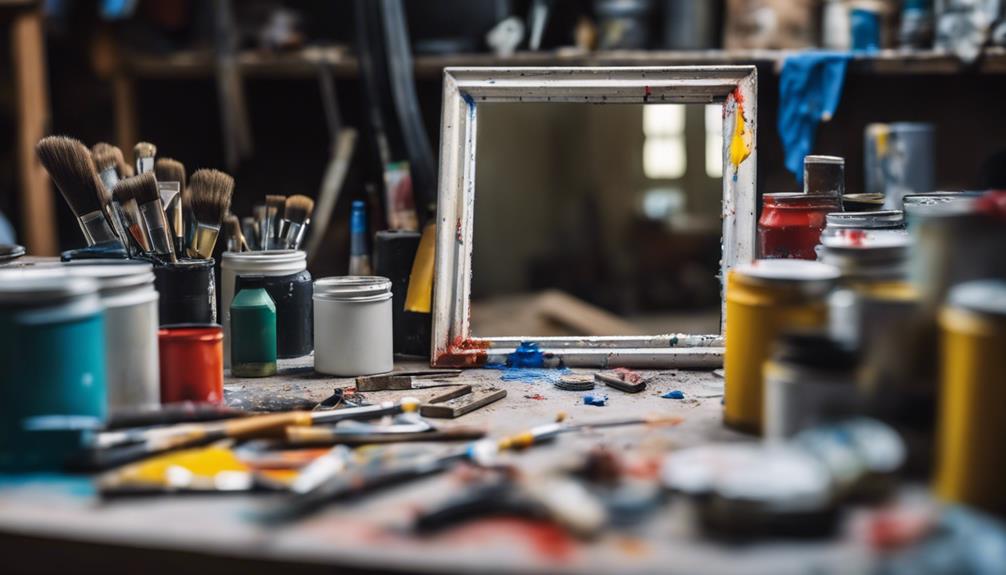We're drawn to navy blue accent walls because they exude a sense of sophistication and drama, making them an ideal way to elevate any room's style and ambiance. From a navy blue geometric pattern to an accent wall with gold accents, the possibilities are endless. You can create a dramatic ceiling accent wall, incorporate cabinetry with a navy blue back, or combine navy blue with cream for a striking contrast. Maximalist accent wall design and show-stopping built-in shelves are also great options. With these 7 inspiring ideas, you'll find the perfect way to add a touch of elegance to your space, and discover even more ways to take your breath away.
Key Takeaways
• Navy blue and cream is a sophisticated color combination suitable for bedrooms and living rooms, adding depth and visual interest.
• Pairing navy blue accent walls with gold accents creates a luxe, chic ambiance, elevated by dramatic color clashes.
• Geometric patterns, florals, and bold designs can be used to create a unique, eclectic, and visually striking accent wall.
• Architectural features like dramatic ceiling accent walls, navy blue cabinetry, and built-in shelves can add sophistication and elegance.
• Bold patterns, vibrant colors, and unique decor can be used to create stunning visual statements that exude personality and creativity.
Navy Blue Geometric Pattern
We're drawn to navy blue geometric patterns because they inject a modern twist into accent walls, effortlessly creating a stylish focal point in any room. These designs add a level of sophistication and visual interest to a space, making it perfect for those who want to elevate their décor.
By incorporating geometric patterns into a navy blue accent wall, we can create a unique and captivating area that demands attention. The contrast of navy blue with geometric patterns enhances the wall's aesthetic, adding depth and dimension to the room.
Additionally, geometric shapes in navy blue can be achieved through wallpaper or paint, making it easy to incorporate this design element into our space. The result is a striking navy blue accent wall that not only adds a modern touch but also creates a sense of visual interest, drawing the eye towards the accent wall.
Accent Wall With Gold Accents
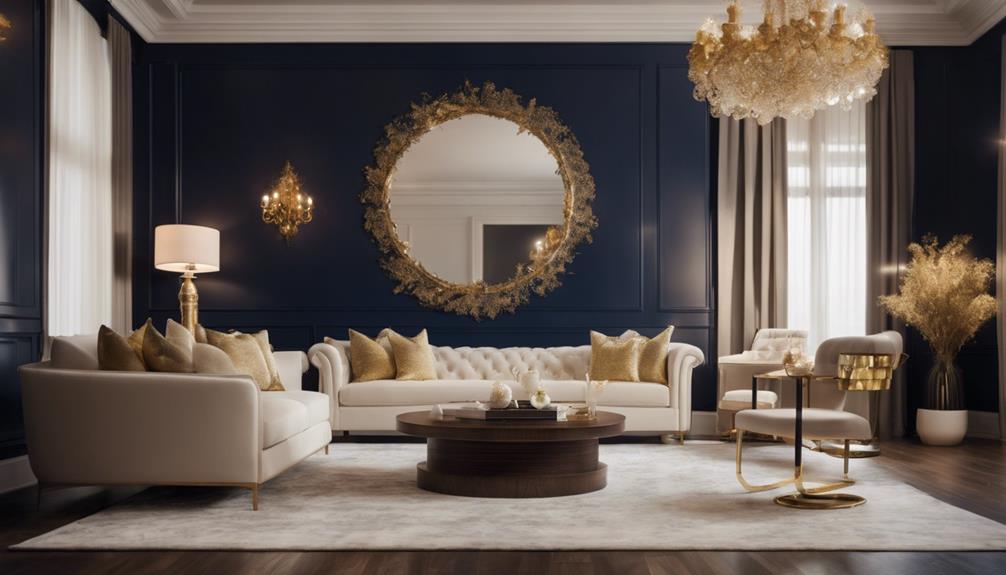
As we explore the possibilities of an accent wall with gold accents, we're drawn to the dramatic visual contrasts that emerge when rich metallic tones meet deep navy blue hues.
We're excited to examine how luxe accent pieces can elevate the overall aesthetic, and how a dramatic color clash can add a touch of glamour to the room.
Rich Metallic Contrasts
Pairing a navy blue accent wall with gold accents instantly elevates the space, imbuing it with a sense of luxury and refinement. We love how the rich metallic contrasts between these two colors create a visually striking and sophisticated finish.
The gold accents enhance the richness of the navy blue, adding warmth and sophistication to the space. This combination creates a chic and stylish ambiance, elevating the overall design aesthetic.
By incorporating gold accents with a navy blue accent wall, we add a touch of glamour and upscale appeal to the room. The contrast between the cool, calm tones of navy blue and the warm, luxurious feel of gold is truly striking. It's a perfect blend of modern sophistication and timeless elegance.
As we explore the world of navy blue accent walls, it's clear that pairing them with gold accents is a match made in heaven. The result is a space that exudes luxury, refinement, and style.
Luxe Accent Pieces
Taking our luxurious design to the next level, we incorporate luxe accent pieces that beautifully complement our navy blue accent wall and gold accents. By combining these two elements, we create a chic and luxurious space that exudes sophistication and elegance.
The addition of gold accents enhances the richness of the navy blue, adding warmth and a touch of glamour to the room. This luxurious look elevates the overall design aesthetic, providing a sense of refinement and poise.
We're not just stopping at the accent wall; we're taking it to the next level with luxe accent pieces that perfectly complement the navy blue and gold color scheme. From ornate vases to metallic decorative accents, every piece is carefully curated to create a cohesive and stylish look.
The result is a space that's both luxurious and inviting, perfect for those who crave a sophisticated ambiance. By incorporating these luxe accent pieces, we've created a truly breathtaking space that's sure to impress.
Dramatic Color Clash
We're drawn to the dramatic color clash of navy blue accent walls paired with gold accents, a luxurious and elegant combination that elevates the room's style and visual appeal. The navy blue accent walls provide a rich, sophisticated backdrop, while the gold accents add a touch of warmth and sophistication to the overall design aesthetic. This dramatic color clash is truly eye-catching and creates a sense of luxury and elegance in any room.
| Design Element | Effect on Room |
|---|---|
| Navy Blue Accent Wall | Rich, sophisticated backdrop |
| Gold Accents | Adds warmth and sophistication |
| Color Clash | Elevates room's style and visual appeal |
| Overall Look | Luxurious and elegant |
The combination of navy blue and gold enhances the richness of the wall color, creating a chic and timeless look that's perfect for any room. Whether you're looking to add a touch of glamour to your living room or create a sophisticated atmosphere in your bedroom, navy blue accent walls with gold accents are a winning combination.
Dramatic Ceiling Accent Wall
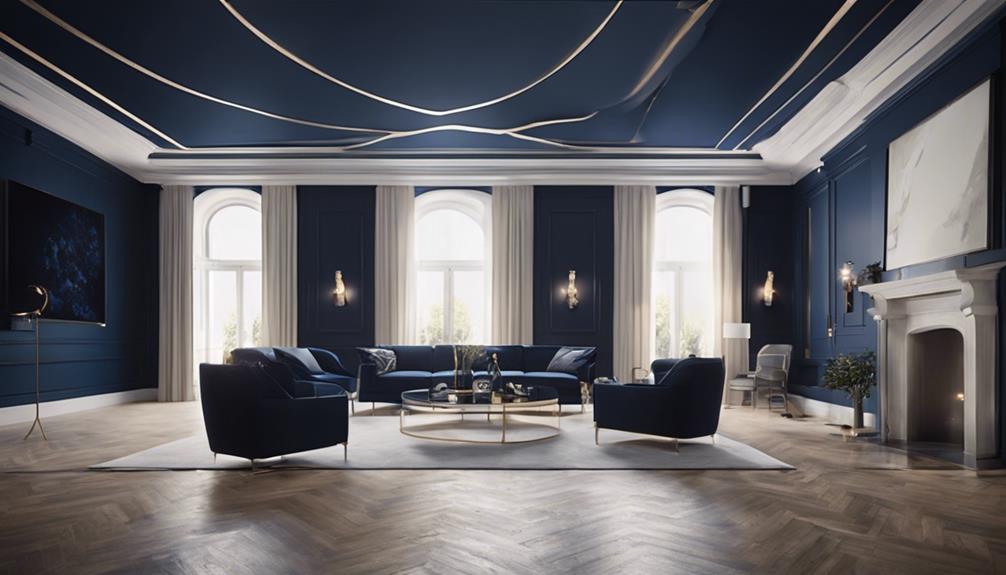
By incorporating a dramatic ceiling accent wall, we can instantly elevate the ambiance of a room and draw attention to its architectural features. This design element creates a bold statement in a room, adding visual interest and depth to a space.
A dramatic ceiling accent wall is particularly effective in highlighting architectural features like beams or skylights, making them a focal point in the room. Additionally, it can create a cozy and intimate atmosphere in larger rooms, making them feel more inviting.
When it comes to incorporating navy blue into our home decor, a dramatic ceiling accent wall offers a unique and impactful way to do so. A navy blue accent wall in a bold color can add a striking touch to a room, drawing the eye upwards and creating a sense of grandeur.
Cabinetry With Navy Blue Back
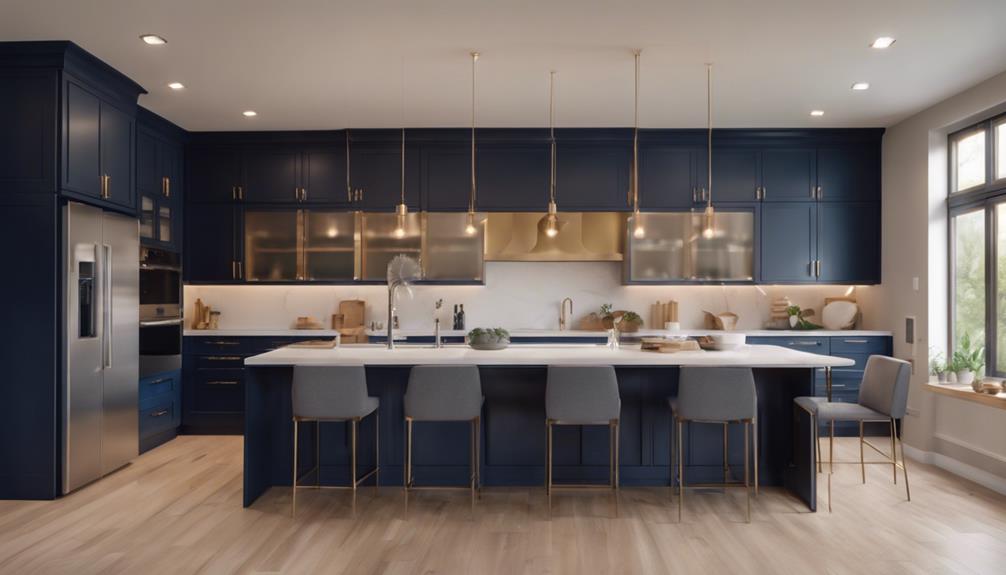
Frequently, our kitchen cabinetry becomes a focal point, and painting the back of it a deep, rich navy blue can instantly elevate the entire space. This accent wall idea adds sophistication and style to various home styles, blending seamlessly with existing decor and elevating the overall aesthetic of the space.
By incorporating navy blue into our cabinetry, we can create a touch of sophistication and enhance the room's design.
Here are three benefits of painting cabinetry navy blue:
- Highlight architectural features: Navy blue cabinetry is ideal for highlighting architectural features and creating a focal point in the room.
- Maximize storage areas: Consider painting cabinetry navy blue to maximize storage areas and add a unique twist to the space.
- Elevate the room's design: Adding navy blue to cabinetry creates a touch of sophistication and enhances the room's design, making it a great Accent Wall Idea for any home.
Navy Blue and Cream Combination
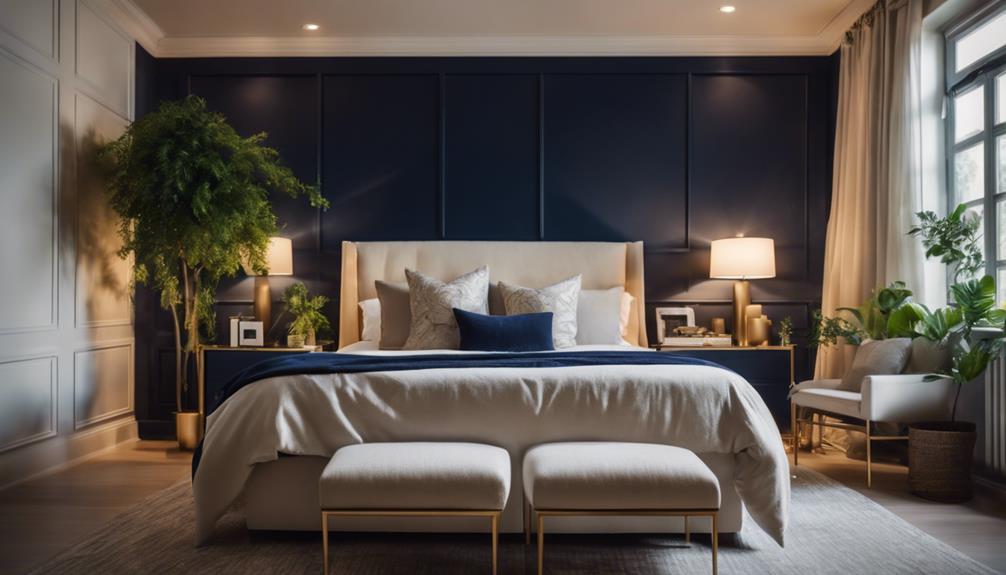
Combining navy blue and cream creates a timeless and sophisticated color palette that can elevate the ambiance of any room.
We love how this classic combination adds depth and visual interest to a space, making it perfect for accent walls. The rich, bold navy blue provides a stunning backdrop, while the cream softens the overall look, creating a beautiful balance.
This versatile combination works well in various spaces, from bedrooms to living rooms, and can be easily incorporated through accent walls, furniture, and decor items.
By pairing navy blue and cream, we can create a sophisticated atmosphere that exudes elegance and refinement. Whether we're looking to add a pop of color or create a calming ambiance, this timeless combination is sure to impress.
With its perfect blend of contrast and harmony, the navy blue and cream combination is a must-try for anyone looking to elevate their space.
Maximalist Accent Wall Design
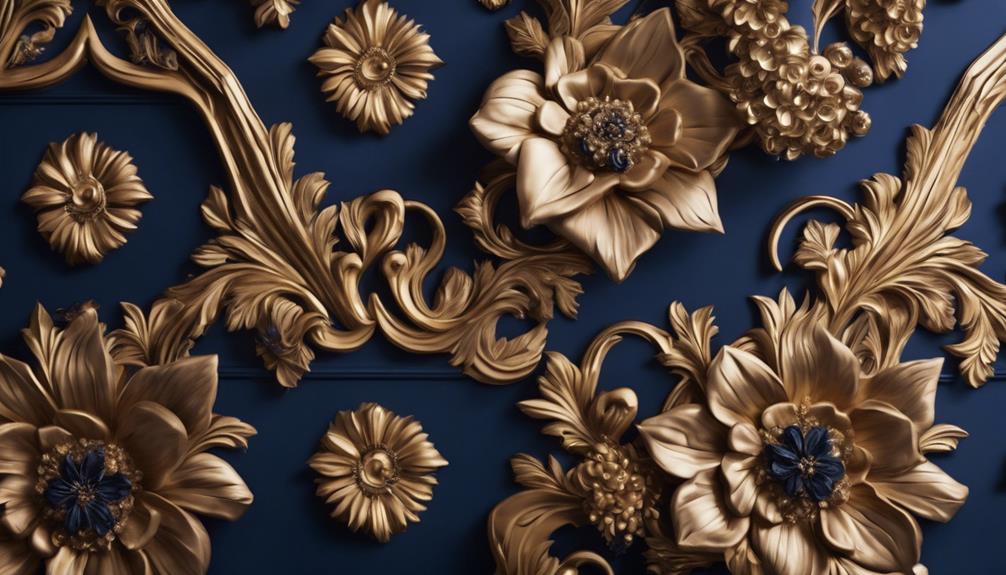
As we step away from the timeless sophistication of navy blue and cream, we're drawn to the vibrant, eclectic world of maximalist accent wall design, where bold patterns, vibrant colors, and eclectic decor elements come together to create a visually stunning statement piece.
In maximalist design, we embrace the 'more is more' philosophy, layering textures, prints, and accessories to create a rich, dynamic accent wall. Here, bold patterns like florals, geometric shapes, and animal prints come together in a lively mix that exudes personality, creativity, and a sense of adventure.
To create a maximalist accent wall, consider the following elements:
- Mix and match patterns: Combine bold, vibrant patterns like stripes, polka dots, and florals to create a visually striking accent wall.
- Add eclectic decor: Incorporate unique, eclectic decor elements like vintage artwork, colorful vases, or statement lighting fixtures to add depth and visual interest.
- Embrace vibrant colors: Don't be afraid to use bold, vibrant colors to create a statement-making accent wall that demands attention.
Show-Stopping Built-In Shelves
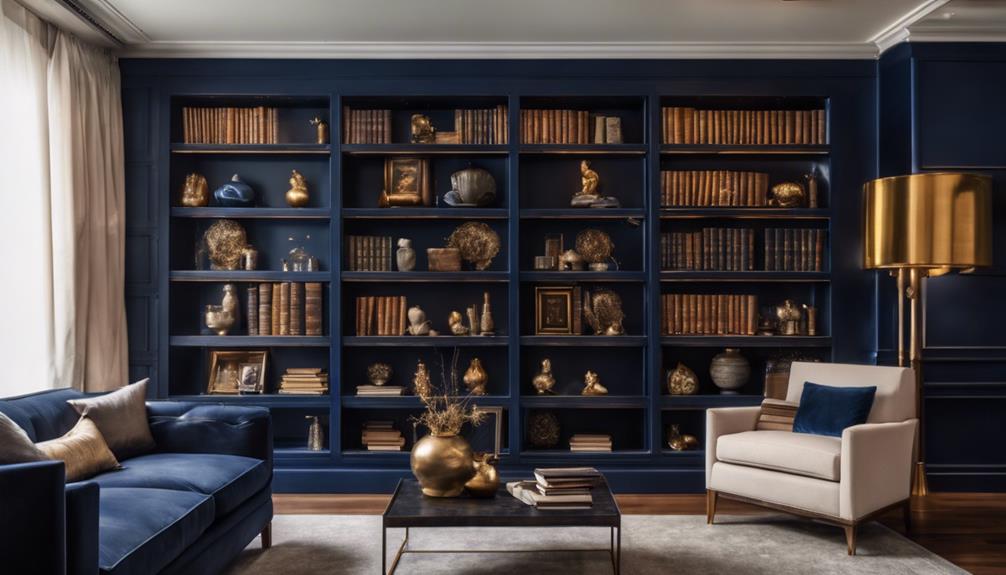
By painting the built-in shelves a deep, rich navy blue, we can create a stunning accent wall that draws the eye and adds a touch of sophistication to the room. This bold color choice emphasizes the architectural features of the built-ins, showcasing their unique design elements and adding character and depth to the space.
By highlighting these shelves, we create a focal point in the room that's impossible to ignore. The navy blue hue adds a level of sophistication and elegance, elevating the room's aesthetic and design. We love how the bold color brings out the intricate details of the built-in shelves, making them a true showstopper.
Frequently Asked Questions
What Color Goes With a Navy Blue Accent Wall?
When we're deciding what color goes with a navy blue accent wall, we often consider a few options.
We like to pair it with white for a classic contrast, or add metallic accents like gold or silver for a luxurious touch.
For a softer look, we might choose pale pink or light gray to balance out the richness of the navy blue.
What Is the Complementary Color of Navy Blue?
As we explore the world of color theory, we find that the complementary color of navy blue is a warm, contrasting shade. Specifically, it's a vibrant hue like coral or peach, which lies directly opposite navy blue on the color wheel.
This striking combination creates a visually appealing contrast, making navy blue stand out even more in a design.
What Color Trim With Dark Blue Walls?
When selecting a trim color to pair with dark blue walls, we consider the overall aesthetic we want to achieve.
It's understood that white trim provides a classic contrast, while light gray trim offers a modern, sophisticated look.
For a warm, inviting feel, we opt for cream or beige trim.
If aiming to add drama, black trim is the way to go.
Ultimately, we choose a trim color that complements the room's style and color scheme.
What Color Should Your Accent Wall Be?
When deciding on an accent wall color, we consider the room's purpose and mood we want to create.
We think about the existing wall colors and how we can create contrast for a striking effect.
We also take into account the natural light in the room and choose a color that complements it.
Conclusion
Incorporating a navy blue accent wall into our design can elevate our space in ways we never thought possible.
From adding a touch of sophistication with geometric patterns to making a bold statement with maximalist designs, the options are endless.
By exploring different styles and combinations, we can create a unique look that reflects our personality and adds depth to our room.
Whether we're going for dramatic or subtle, a navy blue accent wall is sure to leave a lasting impression.
